The NBA’s draft lottery, which takes place annually between the end of the regular season and the draft, is the league’s way of determining the draft order and disincentivizing second-half tanking. The lottery gives each of the 14 non-playoff teams – or whichever clubs hold those teams’ first-round picks – a chance to land one of the top four selections in the draft.
Although the top four picks of each draft are up for grabs via the lottery, the remaining order is determined by record, worst to best. The league’s worst team isn’t guaranteed a top-four spot in the draft, but is tied for the best chance to land the first overall pick and will receive the fifth overall selection at worst.
The first four picks are determined by a draw of ping-pong balls numbered 1 through 14. Four balls are drawn, resulting in a total of 1,001 possible outcomes. 1,000 of those outcomes are assigned to the 14-non playoff teams — for instance, if balls numbered 4, 7, 8, and 13 were chosen, that combination would belong to one of the 14 lottery teams. The 1,001st combination remains unassigned, and a re-draw would occur if it were ever selected.
The team whose combination is drawn first receives the number one overall pick, and the process is repeated to determine picks two, three, and four. The 14 teams involved in the draft lottery are all assigned a specific number of combinations, as follows (worst to best):
- 140 combinations, 14.0% chance of receiving the first overall pick
- 140 combinations, 14.0%
- 140 combinations, 14.0%
- 125 combinations, 12.5%
- 105 combinations, 10.5%
- 90 combinations, 9.0%
- 75 combinations, 7.5%
- 60 combinations, 6.0%
- 45 combinations, 4.5%
- 30 combinations, 3.0%
- 20 combinations, 2.0%
- 15 combinations, 1.5%
- 10 combinations, 1.0%
- 5 combinations, 0.5%
If two lottery teams finish the season with identical records, each team receives an equal chance at a top-four pick by averaging the total amount of outcomes for their two positions. For instance, if two teams tie for the league’s fourth-worst record, each club would receive 115 combinations and an 11.5% chance at the first overall pick — an average of the 125 and 105 combinations that the fourth- and fifth-worst teams receive.
If the average amount of combinations for two positions isn’t a whole number, a coin flip determines which team receives the extra combination. For example, if two clubs tied for the league’s third-worst record, the team that wins the coin flip would receive 133 of 1,000 chances at the first overall pick, while the loser would receive 132. The coin flip also determines which team will draft higher in the event that neither club earns a top-four pick.
The table below displays the odds for each lottery team, rounded to one decimal place. Seeds are listed in the left column, while the picks are noted along the top row. For our purposes, the first seed is the NBA’s worst team.
| Seed | 1 | 2 | 3 | 4 | 5 | 6 | 7 | 8 | 9 | 10 | 11 | 12 | 13 | 14 |
|---|---|---|---|---|---|---|---|---|---|---|---|---|---|---|
| 1 | 14 | 13.4 | 12.7 | 12 | 47.9 | – | – | – | – | – | – | – | – | – |
| 2 | 14 | 13.4 | 12.7 | 12 | 27.8 | 20 | – | – | – | – | – | – | – | – |
| 3 | 14 | 13.4 | 12.7 | 12 | 14.8 | 26 | 7 | – | – | – | – | – | – | – |
| 4 | 12.5 | 12.2 | 11.9 | 11.5 | 7.2 | 25.7 | 16.7 | 2.2 | – | – | – | – | – | – |
| 5 | 10.5 | 10.5 | 10.6 | 10.5 | 2.2 | 19.6 | 26.7 | 8.7 | 0.6 | – | – | – | – | – |
| 6 | 9 | 9.2 | 9.4 | 9.6 | – | 8.6 | 29.8 | 20.6 | 3.7 | 0.1 | – | – | – | – |
| 7 | 7.5 | 7.8 | 8.1 | 8.5 | – | – | 19.7 | 34.1 | 12.9 | 1.3 | >0 | – | – | – |
| 8 | 6 | 6.3 | 6.7 | 7.2 | – | – | – | 34.5 | 32.1 | 6.7 | 0.4 | >0 | – | – |
| 9 | 4.5 | 4.8 | 5.2 | 5.7 | – | – | – | – | 50.7 | 25.9 | 3 | 0.1 | >0 | – |
| 10 | 3 | 3.3 | 3.6 | 4 | – | – | – | – | – | 65.9 | 19 | 1.2 | >0 | >0 |
| 11 | 2 | 2.2 | 2.4 | 2.8 | – | – | – | – | – | – | 77.6 | 12.6 | 0.4 | >0 |
| 12 | 1.5 | 1.7 | 1.9 | 2.1 | – | – | – | – | – | – | – | 86.1 | 6.7 | 0.1 |
| 13 | 1 | 1.1 | 1.2 | 1.4 | – | – | – | – | – | – | – | – | 92.9 | 2.3 |
| 14 | 0.5 | 0.6 | 0.6 | 0.7 | – | – | – | – | – | – | – | – | – | 97.6 |
The NBA’s lottery format was changed in 2019, with that year’s draft representing the first one that used the new system. Previously, only the top three spots were determined via the lottery and the odds were weighted more heavily in favor of the league’s worst teams.
Beginning in 2021, the NBA’s lottery underwent another small change when the league introduced the play-in tournament. The lottery now includes the 10 teams that miss out on the playoffs and the play-in tournament, plus the four clubs that are eliminated in the play-in portion of the postseason.
That means a team can finish the regular season ranked seventh or eighth in its conference, but if that club is eliminated in the play-in tournament, it will be in the lottery. Conversely, a team that finishes ninth or 10th in its conference during the regular season and then wins a pair of play-in games to earn a playoff spot will be a non-lottery team.
Once the 14 lottery teams are determined, their lottery odds are still dictated by their regular season records, so the play-in losers won’t necessarily be the 11-14 “seeds” in the lottery. For example, in 2022, the 34-48 Spurs ended up with better lottery odds than the 37-45 Knicks or 35-47 Wizards, even though San Antonio participated in the Western Conference play-in tournament while New York and Washington didn’t qualify for the East’s play-in.
Note: This is a Hoops Rumors Glossary entry. Our glossary posts will explain specific rules relating to trades, free agency, or other aspects of the NBA’s Collective Bargaining Agreement.
Information from Tankathon.com and Wikipedia was used in the creation of this post. Earlier versions of this post were published in past years.
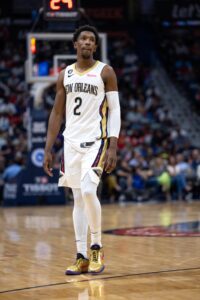 Shedding Graham’s salary over the next couple of seasons — he’s owed $12.1MM in ‘23/24 and a partially guaranteed $2.85MM ($12.65MM base) in ‘24/25 — likely cost the Pelicans at least two second-round picks, if not three. Replacing him with Richardson for an extra second or two was a low-risk maneuver.
Shedding Graham’s salary over the next couple of seasons — he’s owed $12.1MM in ‘23/24 and a partially guaranteed $2.85MM ($12.65MM base) in ‘24/25 — likely cost the Pelicans at least two second-round picks, if not three. Replacing him with Richardson for an extra second or two was a low-risk maneuver.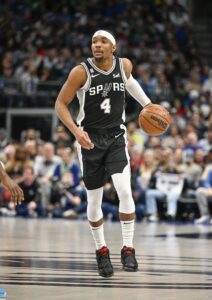 While Graham was redundant on the Pelicans, the Spurs had a glaring need at point guard –
While Graham was redundant on the Pelicans, the Spurs had a glaring need at point guard – 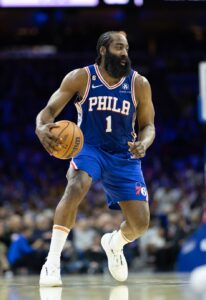 Harden started to look a little old and out of shape in 2021/22, never quite recovering from a reoccurring hamstring injury originally sustained in late ‘20/21.
Harden started to look a little old and out of shape in 2021/22, never quite recovering from a reoccurring hamstring injury originally sustained in late ‘20/21.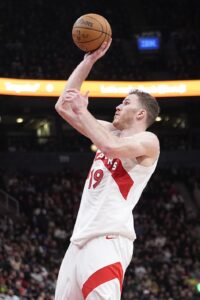 Acquired in a deadline deal with San Antonio, Poeltl has gotten off to a great start in his second stint with Toronto, looking very motivated in averaging 14.9 PPG, 9.2 RPG, 2.5 APG, 1.8 SPG and 1.7 BPG while shooting 69% from the floor and 56.1% from the free throw line through 12 games (28.4 MPG).
Acquired in a deadline deal with San Antonio, Poeltl has gotten off to a great start in his second stint with Toronto, looking very motivated in averaging 14.9 PPG, 9.2 RPG, 2.5 APG, 1.8 SPG and 1.7 BPG while shooting 69% from the floor and 56.1% from the free throw line through 12 games (28.4 MPG).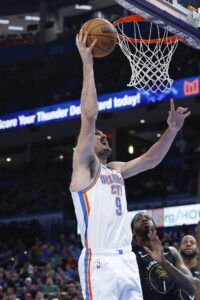 As our Luke Adams explains in our
As our Luke Adams explains in our 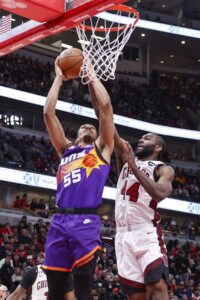 Trading Saric for Bazley saved the Suns approximately $20MM toward their estimated luxury tax payment. According to
Trading Saric for Bazley saved the Suns approximately $20MM toward their estimated luxury tax payment. According to 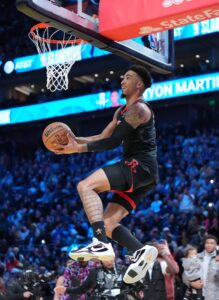 The No. 52 overall pick of the 2020 draft, Martin is averaging career highs with 12.0 PPG and 5.6 RPG while shooting a career-best 56.2% from the field through 65 games (26.9 MPG). The high flier is another player who saw his name mentioned in trade rumors early in the season, but obviously Houston decided to keep him.
The No. 52 overall pick of the 2020 draft, Martin is averaging career highs with 12.0 PPG and 5.6 RPG while shooting a career-best 56.2% from the field through 65 games (26.9 MPG). The high flier is another player who saw his name mentioned in trade rumors early in the season, but obviously Houston decided to keep him.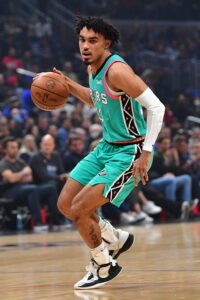 The No. 41 overall pick of the 2020 draft, Jones rarely saw the court in his first season, appearing in 37 games with an average of 7.3 MPG. He saw more action last season, but he was still limited to a reserve role, appearing in 69 games with averages of 6.0 PPG and 3.4 APG in 16.6 MPG.
The No. 41 overall pick of the 2020 draft, Jones rarely saw the court in his first season, appearing in 37 games with an average of 7.3 MPG. He saw more action last season, but he was still limited to a reserve role, appearing in 69 games with averages of 6.0 PPG and 3.4 APG in 16.6 MPG.